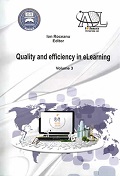EURHYTHMY – MANNER OF ARTISTIC EXPRESSION FOR PUPILS AND STUDENTS
EURHYTHMY – MANNER OF ARTISTIC EXPRESSION FOR PUPILS AND STUDENTS
Author(s): Daniela Aducovschi, Alina Mihaela StoicaSubject(s): Education
Published by: Carol I National Defence University Publishing House
Keywords: eurhythmy; verse; music; movement; harmony; symbol
Summary/Abstract: Generally speaking, eurhythmy can be defined as a harmonious combination of sounds, words, lines and proportions generating a compositional balance, which is very important for the artistic act. In the context of studying, with the purpose of reaching high interpretative and artistic competencies, eurhythmy is represented by: developing human body's expressivity, the capacity of expressing temporal and spatial dimensions, the harmonious bonding between movement, rhythm, sound and color; realizing the connection between the body and the soul. Eurhythmy is an art which express the language and sound through movements. Its first elements were first born in 1911-1912 with the help of Rudolf Steiner, founder of anthroposophy. There are other sciences that developed during the past few years as the science developed itself in: scenic, pedagogical and curative/remedial eurhythmy. Scenic eurhythmy artistically introduces each new concepts or new skills to be discovered and developed. Eurhythmy itself is an art: it uses the body as a visual representation along with the language, the music and the singing that create the atmosphere. It points out the music intervals and tones and the sound through a falling expressive movement of the arms, hands and body in a dynamic structure. The second side is the didactical one that is willing to strengthen the child according to Waldorf's techniques. During eurhythmy classes, the children make up stories or happenings through meaning full movements. As they grow up they acquire the ability of controlling their gestures and steps on specific rhythms and special moves. There is also a third domain developed from eurhythmy, which has its own concepts and figures that are used in treating different deficiencies.
Journal: Conference proceedings of »eLearning and Software for Education« (eLSE)
- Issue Year: 9/2013
- Issue No: 03
- Page Range: 72-77
- Page Count: 6
- Language: English

